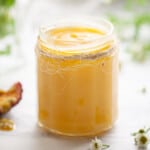Passion Fruit Curd
Passion fruit curd (aka passion fruit butter) is bold and brazen in colour and full of tropical fruit flavour. Not only that, it’s easy to make at home and has a multitude of uses. (Makes 1 x 340g jar)
Servings: 17 Servings
Calories: 80kcal
Ingredients
- 100 ml Passion fruit puree either made from fresh passion fruit or store-bought (see notes)
- 100 g Butter
- 2 Eggs large, free-range
- 120 g Caster sugar reduce if using store-bought puree containing sugar (see notes)
- 1 tablespoon Lime juice
- 1 tablespoon Passion fruit seeds optional
Instructions
Direct Heat Method
- Measure all of the ingredients into a small heavy-based pan.
- Set the pan over a low heat and stir continuously to melt the butter and dissolve the sugar.
- Keep stirring constantly until the temperature reaches 70C/ 160F on a digital food thermometer.
- Strain the curd through a sieve.
- Stir a few seeds in (optional).
- Decant into a jar, let cool completely, then seal and let chill in the fridge for several hours before using.
Indirect Heat Method
- Measure all of the ingredients into a heat-proof bowl.
- Use a bain-marie (double boiler) to cook the curd: suspend the bowl over a saucepan holding 1-2cm of barely simmering water (ensure the bowl is not touching the water).
- Let the contents of the bowl slowly melt and dissolve, whisking frequently.
- Continue to cook, again stirring frequently, until the temperature reaches 70C/ 160F.
- Strain the curd through a sieve.
- Stir a few seeds in (optional).
- Decant into a jar, let cool completely, then seal and let chill in the fridge for several hours before using.
Notes
- Never cook the passion fruit butter over a high heat as this increases the risk of the eggs beginning to scramble.
- If the eggs do begin to scramble, don’t panic. Just remove the pan from the heat, plunge the base of the pan into cold water and keep on stirring. This will help the curd to cool a little and halt the cooking. The cooked pieces of egg can be sieved out at the end.
- Don’t stop stirring at all if using the direct heat method.
- Passion fruit butter gets thicker as it cools, so don’t worry if it looks quite thin whilst cooking. By the time the temperature reaches 70C/ 160F, it should have the consistency of custard and be able to coat the back of a spoon.
- For a change stir through ½ teaspoon of vanilla bean paste to add soft, creamy and fragrant undertones to the zesty tropical flavour of the passion fruit curd.
- Once strained stir through 1 tablespoon of the reserved passion fruit seeds if desired. This will add a little crunch to the texture of the fruit curd.
- The passion fruit curd will stay fresh for around 10 days in the fridge.
- Cut the fruits in half and scoop out the juicy flesh and seeds. Discard the skins.
- Put the flesh and seeds into a blender and pulse briefly to loosen the seeds from the flesh (around three 1-second pulses should suffice).
- Strain the fruit through a sieve to separate the seeds and puree. Stir with a metal spoon – the puree should now easily fall through the sieve leaving the seeds behind.
- Either discard the seeds or reserve a few to stir through the passion fruit curd once cooked.
- If your puree contains 10% sugar then that equates to 10g of sugar per 100ml. Since this recipe requires 100ml of puree, this means we need to reduce the sugar by 10% which is approximately 10g. In other words, use 110g of sugar instead of the 120g listed in the recipe card.
- Similarly, if your puree contains 20% sugar, this means for every 100ml of puree used we should cut out around 20g of sugar from our curd recipe (so use 100g sugar instead of 120g).
Nutrition
Calories: 80kcal | Carbohydrates: 8g | Protein: 1g | Fat: 5g | Saturated Fat: 3g | Polyunsaturated Fat: 1g | Monounsaturated Fat: 1g | Trans Fat: 1g | Cholesterol: 32mg | Sodium: 46mg | Potassium: 26mg | Fiber: 1g | Sugar: 8g | Vitamin A: 218IU | Vitamin C: 2mg | Calcium: 5mg | Iron: 1mg
